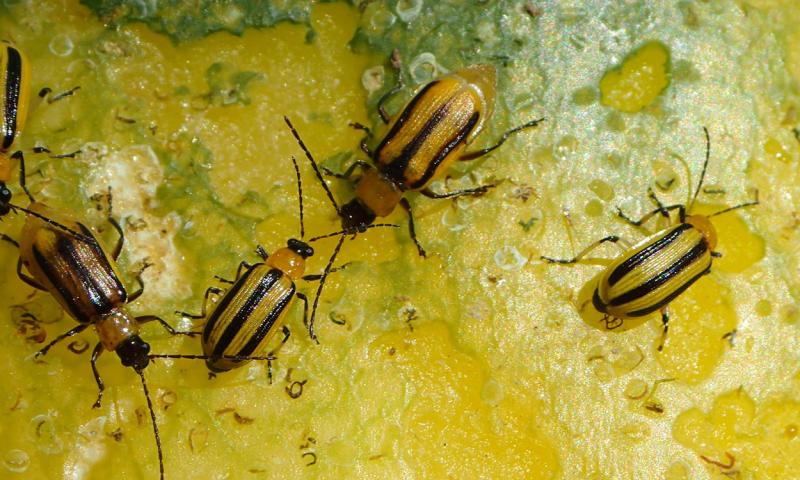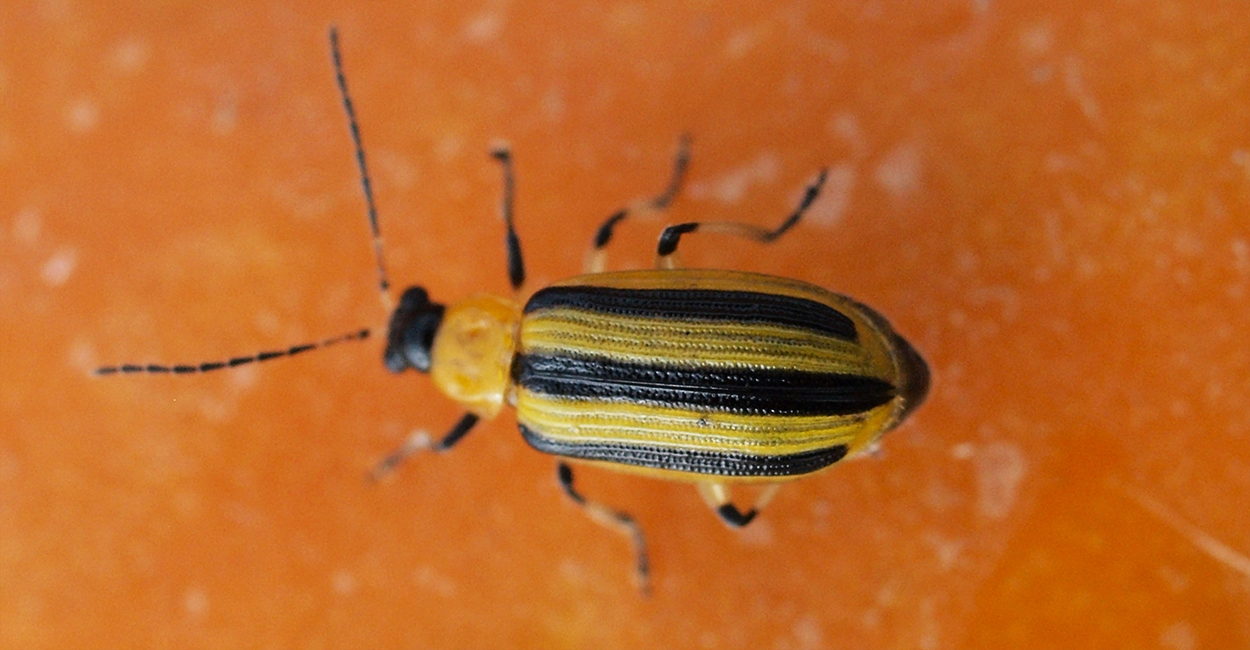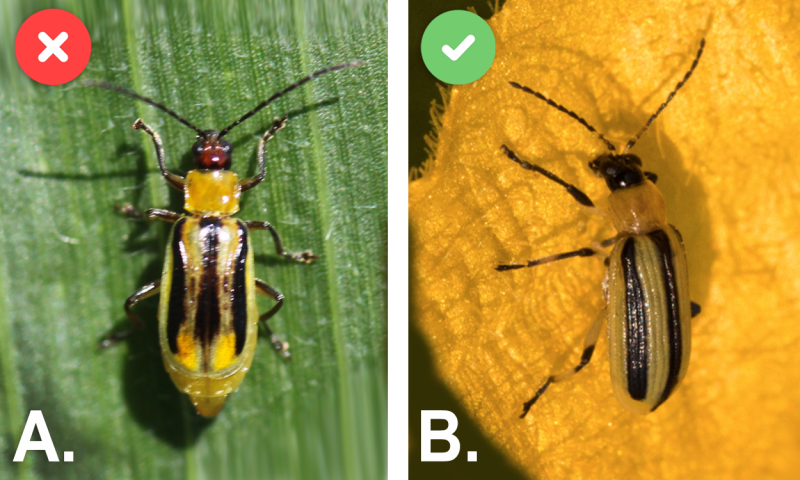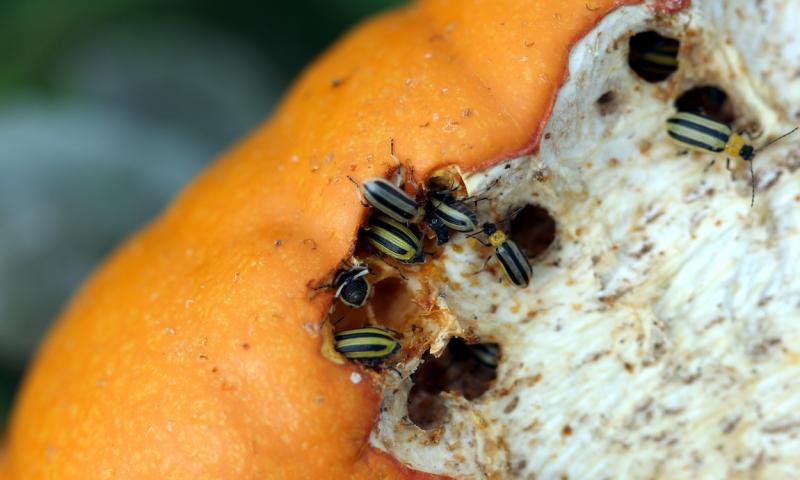
Originally Submitted: June 16, 2023
Written collaboratively by Patrick Wagner, Amanda Bachmann, Philip Rozeboom, Adam Varenhorst, and Brad McManus.
Striped cucumber beetles are showing up in gardens across South Dakota. Although cucumber beetles are often more of an issue later in the summer and early fall, during 2023 they are showing up earlier and causing problems. If large populations are present in a garden, they can cause severe injury to cucurbits (including squash, cucumber, melon and other) if left unmanaged.
Identification
Two cucumber beetle species that occur in South Dakota are the striped cucumber beetle (Figure 1) and the spotted cucumber beetle, which is also known as the southern corn rootworm (Figure 2). The striped cucumber beetle is most common and is the main threat to gardens. The spotted cucumber beetle appears less frequently and is more common East River.
Striped Cucumber Beetle

Spotted Cucumber Beetle

The adults of both cucumber beetle species are approximately one-quarter of an inch long and have yellow elytra (or hardened wing covers) with black markings. Striped cucumber beetles have three distinct black stripes that run lengthwise on their backs, whereas spotted cucumber beetles have twelve black spots. The larvae of both species are small, cream-colored and live in the soil, where they feed on roots. The larvae of both species are rarely observed unless the roots of the plants are dug up.
Western Corn Rootworm vs. Cucumber Beetles

There is sometimes confusion in identifying western corn rootworms as cucumber beetles and vice versa. Western corn rootworm adults can be differentiated by their less-distinct black stripes that sometimes bleed together (Figure 3-A).
The stripes on the western corn rootworm also do not extend to the tip of the abdomen. The underside of the western corn rootworm is yellow, whereas the underside of the cucumber beetle abdomen is black. In addition, the western corn rootworms have black legs, whereas the striped cucumber beetles have yellow legs with black joints (Figure 3-B).
Behavior
Adult cucumber beetles overwinter in debris and become active in the spring. They search for cucurbits to feed on, mate, and lay eggs. Cucumber beetles often go unnoticed until the next generation of adult beetles emerge during the summer and populations dramatically increase. The larvae developing in the soil have little to no impact on plant health. However, the adults feed on the stems and foliage of cucurbits. Cucumber beetles are the vectors of bacterial wilt, which is a disease that can quickly infect many types of cucurbits. The bacteria that cause bacterial wilt plugs up the vascular tissue of cucurbits, causing the vine to wilt and die. There is no recovery for plants once they are infected. As the plants mature, the beetles will progress to feeding on the flowers, and eventually the fruit. Cucumber beetle feeding can result in girdled stems, widespread defoliation, and spoiling of cucurbit fruit (Figure 4).

Management
Several cultural practices can be applied to prevent infestations from becoming severe. At planting time, place mulch around cucurbits to deter cucumber beetle adults from laying eggs near the plants. Removing mulch and debris after harvest can then reduce the number of overwintering sites for cucumber beetles. If you detect signs of bacterial wilt, be sure to remove the infected plants quickly so that cucumber beetles are unable to feed on them and spread the disease. Destroy infected plants and do not put them in your compost pile, as they can remain a source of inoculum for the following season.
Early detection is critical, so be sure to regularly scout cucurbits throughout the growing season. The threshold for managing cucumber beetles is when you detect two or more beetles per plant or when estimated defoliation of leaves reaches 25%. Once cucumber beetles reach threshold levels, consider applying an insecticide to avoid extensive injury to the infested crop. If applying an insecticide, make sure to avoid applications when plants are flowering to minimize the impact to pollinators. Be sure to read and follow the label directions pertaining to the pre-harvest interval, and properly clean produce after harvest to reduce any potential insecticide residuals.


